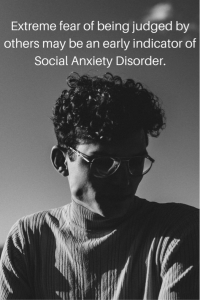If you are a parent of a shy adolescent, it is common to wonder whether your teenager’s timid behavior is negatively impacting their future. A 2016 study by the National Institute of Mental Health (NIMH) found that about half of all teens in the United States describe themselves as shy. Many parents worry whether shy behavior is limiting their child’s ability for normal development. They question whether and when to push their teenager into more social interactions.
Shyness is a personality trait that affects an adolescent’s temperament. A shy teen may be reluctant to enter some social situations or take longer to warm up to new friends. Most adolescents feel shy at least occasionally, but can eventually adjust and enjoy participating in social activities with their peers. If the teenager’s shyness leads to avoiding new experiences, or limiting interactions with new people, it can lead to Social Anxiety Disorder (SAD). The 2016 NIMH study found that around the age of 13, SAD emerges in approximately 12 percent of teenagers who identify as shy. SAD can have a long-term negative impact on a child’s development.
If you have a shy teenager, these are some symptoms that may be early indicators of Social Anxiety Disorder:
Possible Symptoms of Social Anxiety-Behavioral and Emotional
- Intense fear of situations where the teen may be judged by others
- Feeling overwhelming anxiety when around unfamiliar people
- Excessive fear of being embarrassed or humiliated by their own actions
- Fear and avoidance of social situations
- Extreme fear of being thought foolish by others, even with an understanding that the fear is unreasonable
- Dread of social events that begins days or weeks in advance
- Severe test anxiety
- Irritability or anger before a social event
- Hyper-sensitivity to criticism
- Poor school performance
Possible Symptoms of Social Anxiety-Physical
- Trembling or shaking when around others
- Blushing, flushed skin
- Difficulty speaking, shaky voice
- Rapid heart beat
- Sweating
- Nausea
- Feeling dizzy or faint
 If your teenager exhibits the symptoms above and these symptoms are creating impairment in their functioning, there are several ways a parent can help improve the situation. Kashden, et al (2001) stress the benefits of early intervention when Social Anxiety Disorder is suspected. Teenage SAD sufferers can often create a way of life that alleviates their fears, often by using avoidance as their primary coping skill. This avoidance strategy can create a lost opportunity to establish healthy social skills that typically develop during the transition from adolescence to adulthood. Long-term sufferers of Social Anxiety Disorder are at greater risk of developing additional mood, behavioral, and substance abuse issues.
If your teenager exhibits the symptoms above and these symptoms are creating impairment in their functioning, there are several ways a parent can help improve the situation. Kashden, et al (2001) stress the benefits of early intervention when Social Anxiety Disorder is suspected. Teenage SAD sufferers can often create a way of life that alleviates their fears, often by using avoidance as their primary coping skill. This avoidance strategy can create a lost opportunity to establish healthy social skills that typically develop during the transition from adolescence to adulthood. Long-term sufferers of Social Anxiety Disorder are at greater risk of developing additional mood, behavioral, and substance abuse issues.
Parental Support Suggestions: Things to Try
- Discuss the evolutionary origins of anxiety. Ask your teenager to do some research on the evolutionary development of anxiety. https://jamesclear.com/evolution-of-anxiety is one good internet resource for this topic. Talk through the “fight or flight” response that was once essential in keeping humans alive, but now can create unnecessary stress responses to fearful situations. Helping a teenager understand the reasons for physical changes during periods of stress can be beneficial in normalizing their responses.
- Teach calming techniques. When anxiety does trigger physiological changes, one of the most noticeable responses is rapid breathing. Breathing quickly can lead to an imbalance in oxygen and carbon dioxide, which may lead to increased heart rate, muscle tension, and dizziness. This vicious cycle can be easily broken by using calming breath techniques. Work with your teen to find an effective calming exercise. Experiment together with different approaches to find the technique that is most effective in calming anxiety. The following website describes one popular approach. https://www.anxieties.com/57/panic-step4 . Once your teenager believes in their ability to reduce the physiological symptoms, they will develop confidence in their ability to control anxiety.
- Gather more information by talking with your teenager about their specific challenges. If you have identified the presence of Social Anxiety symptoms, talk with your teen to find out which social situations or interactions are the most challenging. Some helpful questions to ask are: “What is your most feared situation?” “Are you afraid of being embarrassed?” “Do you worry about what your classmates think of you?” “Do you hate talking in a large group?” Ask them to help you make a list of their most distressing situations. Use this list to set up specific strategies to alleviate their symptoms.
- Adjust Expectations. Social anxiety and perfectionism commonly occur together. Fear of not meeting high personal expectations heavily contributes to anxiety. Talk with your teenager about how mistakes are part of the growth process. Ask them to share experiences that they label as “failures”, and help them see the benefits of not always succeeding immediately.
- Problem Solving. Help your adolescent find ways to face fears, rather than avoid them. Ask them to describe a situation when they were reluctant to participate. Encourage them to brainstorm ideas that may make it easier the next time. Ask “What would happen if you did it this way?” “What would be the worst possible result?” “What’s the likelihood that the worst possible result would happen?” “Would this make you feel better?” Help them work through their fears in advance and create a new plan for future anxiety-provoking situations.
- Conquering negative thoughts. Adolescents with SAD often believe negative thoughts about themselves, others or the situation, without much evidence supporting those thoughts. Some common ideas are: “I know I will fail.” “They will see that I am really stupid.” “If I blush while I am talking, my social life is ruined.” “My teacher is in a bad mood, I must have failed yesterday’s exam.” Challenge your child to recognize that these thoughts are unrealistic and probably incorrect. Help them develop alternative explanations to these negative ideas. Practicing this activity together can help them create a more positive view of their world.
- Model Social Behavior. Allowing your teenager to see you experience nervousness about a situation, and then see you confront that situation anyway, is one of your most powerful tools in helping them through their social challenges. Talk with them about your feelings before and after the situation and explain the changes that took place as your confronted your fears. Encourage them to take a similar risk.

Parent Support Suggestions: Things to Avoid
- Criticizing. Criticizing your child’s beliefs or behaviors is counter-productive in helping them make changes. Always focus on positive progress.
- Labeling as Shy. If a parent, teacher, or doctor labels an adolescent as “shy”, it can lead the teenager to believe making changes is not possible. Labeling can encourage them to continue unhealthy coping techniques, especially avoidance.
- Blaming. Don’t blame yourself or your teenager for the social anxiety problems. There are many possible contributing factors that lead to the development of these symptoms. Focus on the future and practice techniques to make beneficial changes.
- Accommodating Avoidance. Allowing your child to stay home from school or avoid all social events will reinforce their fears. Provide gentle support and guidance while encouraging participation.
Parental Support Suggestions: When to Seek Professional Help
If your teenager’s Social Anxiety symptoms are present for six months or more, and they are not changing after trying the above ideas, you may want to seek professional help. A therapist with specialized training in Social Anxiety treatment that includes Cognitive Behavioral Therapy can offer further support for parents who continue to be concerned with their teenager’s behavior. Additionally, therapists who specialize in treating anxiety disorders in adolescents can work directly with your teen to develop a treatment plan to ease their symptoms and establish healthy social habits.
Sources:
National Institute of Mental Health (2016). ANXIETY DISODERS. https://www.nimh.nih.gov/health/topics/anxiety-disorders/index.shtml
Kashdan, Todd & Herbert, James. (2001). Social Anxiety Disorder in Childhood and Adolescence: Current Status and Future Directions. Clinical child and family psychology review. 4. 37-61.
Share this blog post











